
Wine Culture and Information since 2002 - Volume 22
 Wine Culture and Information since 2002 - Volume 22 |
|
Issue 198, September 2020 |
Contents |
|
|
Wine Restarts from Harvesting 2020 |
|
It is difficult, in this period, to talk about anything other than the planetary situation determined by the Covid-19 pandemic. Furthermore, it is difficult to separate wine from this subject as it is, like all other productive and economic sectors, strongly affected by its effects. It seems difficult, in fact, in the current state of things, to make predictions because of the general uncertainty we are going through and the only certainty we have are facts, what they produce and have produced in recent months. We are forced to navigate on sight, with not exactly encouraging market results, although there are clear signs of recovery, however not enough to recover the losses. We certainly must start over from somewhere and, as the effects of the pandemic have obviously not altered the cycle of the seasons, the vines in vineyards are now about to give the new bunches of grapes, ready to be harvested. In some parts of Italy, as a matter of fact, harvesting has started some weeks ago, especially in the areas where sparkling wines are produced and in many southern regions. In the time when part of the wine of vintage 2019 has already taken its way to the distillery in order to obtain alcohol to be used for the production of disinfectant gel – a product, unfortunately, in great demand in this period – it is also the time to start a new chapter and in which we all are having high hopes for the immediate future. Two thousand and twenty has definitely been, to say the least, a nefarious year for wine: it started with the protectionist measures of duties by the United States of America and which caused a lot of troubles for the wine market, then – as if all that was not enough – has been declared the Covid-19 pandemic, inflicting another and very heavy blow to wine economy and related activities. It is clearly too early to make any reliable prediction, as the harvesting period in Italy may also last for over three months – in some cases, in fact, the grapes are harvested even in November – however, the news coming from the regions that have already started harvesting seem to be encouraging. In particular, as already mentioned, from the southern regions of Italy and in the areas committed to the production of sparkling wines. At the moment we can of course make a preliminary estimate only as, in any case, the quality of which we can talk about now is the presumed one obtained by the observation of the ripening grapes and which, apparently, seems to be very good in all Italy. All this, of course, hoping Mother Nature will spare us from unwelcome surprises by means of negative weather events that whoever is working in the agriculture knows very well to be an unpredictable and constant risk. In general terms, it should be said the constant presence of the sun and the sultry temperatures which characterized July and August seem to have accelerated – something easily predictable – the ripening of the grapes, thus anticipating the start of harvesting. In particular, in addition to the grapes typically used for the production of sparkling wines, the harvesting operations in this summer months have mainly involved Chardonnay, Sauvignon Blanc and, in general terms, white grape varieties. The first remarks coming from producers, talk about a very high quality of the grapes although there is a decrease in quantitative terms compared to 2019. The decrease in quantity, in any case, does not seem to excessively worry the wineries which, we should not forget that, still have the non so trivial problem of selling last year's wines in the market. In any case, the supposed – and hopefully, confirmed – quality of the grapes of 2020 harvest is certainly excellent news giving us good hopes for the near future. It is impossible, in fact, to forget or not to consider the negative effects of the pandemic on the wine economy, with huge drops in sales, especially in the important share represented by exports. Regarding vintage 2020, it is expected a production of 45 million hectoliters, with a decrease of about 5% compared to 2019. This decrease is largely due to the containment measures adopted during the so-called lockdown and which provided, in fact, for a lowering of yields in the vineyards. Harvesting 2020, despite the prediction on the quality of the grapes, is positive and encouraging, it however seems to face practical difficulties, specifically, the availability of labor and operators who will actually be in the vineyards to harvest the bunches. Due to the restrictions imposed by the Covid-19 pandemic, workers usually coming from abroad are having some problem to reach or enter Italy. In fact, it should be noted that, in most cases, during the period of harvesting, wineries usually hire additional personnel and labor in order to satisfy the greater workload and which certainly cannot wait. In other words, when the grapes are ripe they must be harvested and the operation cannot be delayed, in order to avoid over-ripening, thus compromising the quality of wine. Just as happens in other areas of agricultural production, workers from abroad are often hired and, due to the restrictions imposed by preventive and health measures, many have had difficulty in reaching Italy or have been denied entry in our country. These are time-based contracts, with a validity strictly necessary to cover the harvesting period only, often with the help of temporary agencies in Italy or from other countries. This is an important share of the economy generated by the wine sector, one of the many and obviously not the only one. The other main European wine producing countries – France and Spain – are facing the same difficulties and, not least, the same doubts and perplexities about wine market. For these countries, in addition to the measures adopted because of the Covid-19 pandemic, have also played a significant negative role the duties imposed by the United States of America and which have produced significant losses in exports. In this regard, the case of Champagne is emblematic which, right because of the drastic drop in sales in 2020 – both due to the Covid-19 pandemic and to the duties imposed by the USA- – they decided for a drastic reduction of yields and production. This year, in fact, in Champagne will be produced 230 million bottles only: a number that makes us think if we compare it to the productions of past years and which were over 300 million. These times – and we all unfortunately know it – are not simple and raise epochal and certainly complex problems to solve. Somewhere, however, we have to start again and harvesting 2020 certainly is an excellent starting point. The quality, they say, is very high and this will lead to the production of great wines. A good reason to be optimistic for, although concretely realistic and without excessive illusions. This is a gigantic effort – however necessary and fundamental – and it is all too understandable that wineries, already in evident troubles because of the market trend in 2020, are now forced to make other and difficult decisions. Starting from the vineyard, then continuing in the winery, finally to the bottle. Somewhere and in some way we need to start again. It will be hard – it is already very difficult, and we all know this very well – but in the end it will be a success. I am optimistic and I am convinced of it. The storm does not last forever: sooner or later, inevitably, arrives the rainbow. Antonello Biancalana
|
||||
Contrasts of Rosso di Montalcino and Montefalco RossoTwo interesting appellations of Tuscany and Umbria are compared in the glasses of this month's tasting by contrast |
|
In the vast enological scenario of Italy – which currently counts 406 appellation areas, 77 of these are DOCG, in addition to 118 IGT – in many cases the wine production territories overlap with other denominations. This is exactly what happens for the wines of this month's tasting by contrast, which production areas coincide with two giants of Italian enology. Furthermore, in some cases the appellations extend into different regions – although bordering – and in many cases it is also provided for the production of different styles of wines. Finally, some denominations are exclusively committed to a single wine and, therefore, to a single style, as in the case – for example – of Rosso di Montalcino, for which exists only the red style and the exclusive use of Sangiovese variety. As for Montefalco, on the other hand, in addition to the red style, the appellation provides for the production of white as well. In particular, as already mentioned, in the territory in which are being produced the wines of our tasting by contrast – Rosso di Montalcino and Montefalco Rosso – are also defined the areas of two magnificent DOCG wines: Brunello di Montalcino and Montefalco Sagrantino. In this regard, it must be said this is not the only case in Italy as other DOCG territories also provide within them – in part or completely – the presence of DOC areas. The mistake most frequently made in these cases is to consider DOC wines within the DOCG territories as “lesser wines” or, worse, modest productions compared to those having a Denomination of Controlled and Guaranteed Origin. This is a completely wrong belief and which, moreover, has no practical support because, as in the case of Montefalco, are used even different grape varieties and not allowed in the DOCG denomination. Therefore, these are wines following distinct viticultural and wine making practices, therefore producing completely different results.
|
|
Montalcino, a famous wine municipality in the province of Siena, provides for the production of two distinct wines within its territory: the celebrated Brunello and Rosso. Both wines are produced with Sangiovese – which here in Montalcino is called Brunello – and, specifically, from the clone once known as Sangiovese Grosso. It should be noted that until a few years ago the distinction between grosso (big) and piccolo (small) clones was a characteristic considered fundamental for Montalcino wines, underlining, in fact, the exclusive use of the so-called Sangiovese Grosso. Today, however, we tend to consider only the Sangiovese variety without any other distinction, a production characteristic which – among the other things – is also specified in the production disciplinary of Rosso and Brunello di Montalcino. The two wines are produced in the same territory, however they are distinct productions as they have, above all, their own identities and are, not least, the result of different wine making practices. Apart from the territory and Sangiovese, the two wines differ in their enological practices and are defined in their respective production disciplinary. Brunello di Montalcino must age in oak barrels for at least 24 months, Rosso, on the other hand, can be marketed starting from September 1st of the year following that of production. It should also be noted that, in general terms, the grapes destined for Rosso di Montalcino come from vineyards which are not usually used for the production of Brunello. However, this should not lead to the false belief Rosso di Montalcino is the lesser brother of Brunello di Montalcino or a wine of lower value. Not only they are two different wines but, in some cases, it is possible to find some Rosso di Montalcino which are, in terms of quality, far better than some Brunellos. Finally, it must be considered that, according to the disciplinary, during the vinification process, Rosso can be promoted to Brunello, provided it fully satisfies the requirements of the DOCG wine.
|
||||
|
Montefalco Rosso, just like Rosso di Montalcino, suffers from the gigantic presence of the wine belonging to the “greater denomination”, in this case, Montefalco Sagrantino. Compared to the two Tuscan wines, in this case they are completely different wines and produced with different grapes, having in common, in addition to the territory, the Sagrantino variety – undisputed king of Montefalco – which, in any case, in the Rosso is used in “relatively marginal” quantity. Montefalco Rosso is in fact mainly produced with Sangiovese, which must be present for 60-70% of the total, while the rest is represented by Sagrantino – about 10-15% – and other red berried varieties allowed in Umbria region. Montefalco Rosso is therefore, and in any case, a multi-varietal wine that always provides for the presence of Sangiovese and Sagrantino, with a large dominance of the former. As for wine making procedures, the production disciplinary of Montefalco Rosso provides for a minimum aging period of at least 18 months. The disciplinary also provides for the riserva style, produced with the same grape base and with a minimum aging period of 30 months, of which at least 12 in wooden barrels. As for the varieties that make up Montefalco Rosso, in addition to Sangiovese and Sagrantino, the producers show an interesting resourcefulness thanks to the use of both Italian and international varieties – alone or together – of course allowed for cultivation in Umbria. The result is represented by sensorial profiles which allow the creation of an identifying style for each producer, thanks to organoleptic factors which can contrast or accentuate the specific qualities of Sangiovese and Sagrantino. However, it must be considered the remaining part of the grapes, because of the allowed percentage, does not significantly alter the sensorial qualities of Sangiovese and Sagrantino which, in any case, are always easily recognizable in this wine.
|
The choice of wines for this month's tasting by contrast is certainly easy as the presence and variety of both wines on the market is really wide. However, we will pay attention to the vinification method used for both wines, by making sure they are produced with exactly the same enological process. In particular, we will pay attention to the container used for aging and make sure it is the same for both wines, possibly choosing those aged in large casks. Furthermore, when choosing Montefalco Rosso, it is also important to consider the varieties supporting Sangiovese and Sagrantino and which contribute to the sensorial profile of the wine. For example, if our choice is in favor of a wine in which Merlot is present, it is very likely that, on the gustatory level, the sensation of roundness is more intense than that in which this variety is not used. As for the vintage, our choice is in favor of bottles belonging to the most recent vintage available on the market. Finally, the wines are served in tasting glasses at a temperature of 18 °C. (65 °F) Let's pour the two wines of our tasting by contrast and start the evaluation of each sensorial phase. The first wine we will examine is Rosso di Montalcino, starting with the evaluation of the appearance. By tilting the glass over a white surface – a sheet of paper is enough – let's observe the color and transparency at the base. We note a bright ruby red color and moderate transparency: the object placed in contrast between the glass and the wine is quite visible. Let's now observe the nuance of Rosso di Montalcino, towards the opening of the glass where the thickness of the wine becomes thin, which confirms the ruby red color. Let's now pass to the evaluation of the appearance of Montefalco Rosso, observing the base of the glass. The Umbrian wine shows an intense ruby red color, deeper than Rosso di Montalcino, and a lower transparency than the Tuscan wine. The nuance of Montefalco Rosso – observed at the edge of the glass – confirms the ruby red hue. The olfactory profiles of Rosso di Montalcino and Montefalco Rosso reveal evident and substantial differences. Both wines are produced with Sangiovese – in the Tuscan wine it is the only variety allowed, in the Umbrian wine it is blended to other grapes – however it should also be considered the different territories and, in particular, the huge diversity represented by the countless Sangiovese clones cultivated in Italy. In general terms, in Sangiovese we often perceive aromas of red and black berried fruits, in particular, black cherry, cherry, plum and raspberry, as well as floral sensations reminiscent of violet and, often, rose and geranium. In Montefalco Rosso, therefore, the olfactory sensations typical of Sangiovese will also be joined by those of the other varieties used for the production, in particular those of Sagrantino, characterized by the typical aroma of blackberry. To these are added, in both wines, the aromas given by the aging in wood and which are strongly determined by the type of wood and the volume of the container, as well as the time of aging. Let's resume our tasting and proceed with the analysis of the olfactory profiles of Rosso di Montalcino and Montefalco Rosso. The first wine we examine, as in the previous phase, is Rosso di Montalcino. Let's hold the glass in vertical position and, without swirling, let's do the first smell in order to evaluate the opening aromas of the wine. The typical qualities of Sangiovese are all well perceptible and in good evidence: in fact, from the glass you can perceive intense and clean aromas of black cherry, plum and violet, as well as the elegant touch of rose and raspberry. Let's proceed with swirling the glass – an operation favoring the development of wine aromas – and let's do a second smell. The profile of Rosso di Montalcino is completed with blueberry, pomegranate and the qualities given by the aging in wood, in particular vanilla. Let's now pass to the evaluation of the aromas of Montefalco Rosso, starting from its opening. From the glass we can perceive intense and clean aromas of black cherry, plum and blackberry, followed by the elegant touch of violet. After having swirled the glass, the profile of this wine is completed with blueberry, black currant as well as the typical sensations of the aging in wood. Let's now analyze the gustatory profiles of the wines of this month's tasting by contrast, starting – as in the previous phases – with Rosso di Montalcino. Let's take a sip of the Tuscan wine and evaluate its attack, that is the initial sensations that are perceived in the mouth. The crispness of acidity is one of the qualities that are perceived in the mouth – a typical characteristic of Sangiovese – and astringency is rather moderate, however the effect of alcohol and the roundness given by the aging in wood give Rosso di Montalcino a perfect balance. In the mouth are perceived flavors of black cherry, plum and raspberry, confirming the correspondence to the nose. Let's now take a sip of Motefalco Rosso and evaluate its attack. Also in this case we perceive the crispness of Sangiovese, however in this wine astringency and roundness are more intense. The structure, in general terms, is usually fuller than that of Rosso di Montalcino, certainly thanks to the presence of the powerful Sagrantino. The correspondence to the nose is very good and are clearly perceived the flavors of black cherry, plum, blackberry and blueberry. The final phase of the tasting evaluates the sensations the two wines leave in the mouth after swallowing, in particular, the so-called “taste-olfactory persistence”, a primary and fundamental factor of quality. The finish of Rosso di Montalcino is persistent and leaving in the mouth the pleasing sensation of the typical crispness of Sangiovese, as well as a moderate perception of roundness and astringency. In the mouth are still perceived – intense and clean – the flavors of black cherry, plum and raspberry. The finish of Montefalco Rosso is characterized by a good persistence and in the mouth the sensation of the crispness of Sangiovese is mitigated by the effect of the other grapes used for the production, with a perceptible roundness and astringency such as to keep the wine in balance even in the final phase of tasting. Moreover, in the mouth are perceived intense and clean flavors of black cherry, plum, blackberry and blueberry. Let's now place the two glasses side by side and make a final evaluation of the first three phases of the tasting: the differences are still evident and clear. In particular, in Montefalco Rosso is interesting the evaluation of the sensorial effect of the other grapes in relation to Sangiovese which, instead, in Rosso di Montalcino, so to speak, is pure and uncontaminated.
|
||||||||
Wines of the Month |
|
|
|
Score legend Prices are to be considered as indicative. Prices may vary according to the country or the shop where wines are bought |
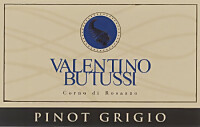
|
|
Colli Orientali del Friuli Pinot Grigio Ramato 2018 |
|
| Valentino Butussi (Friuli-Venezia Giulia, Italy) | |
 Pinot Grigio Pinot Grigio | |
| Price: € 18.00 | Score: |
 Pale onion skin pink and nuances of onion skin pink, transparent. Pale onion skin pink and nuances of onion skin pink, transparent. Intense, clean, pleasing and refined, starts with hints of green
apple, pear and hawthorn followed by aromas of pink grapefruit, plum,
pineapple, broom and almond. Intense, clean, pleasing and refined, starts with hints of green
apple, pear and hawthorn followed by aromas of pink grapefruit, plum,
pineapple, broom and almond.
 Crisp attack and however balanced by alcohol, good body, intense
flavors, pleasing roundness. Crisp attack and however balanced by alcohol, good body, intense
flavors, pleasing roundness.
 Persistent finish with flavors of green apple, plum and almond. Persistent finish with flavors of green apple, plum and almond. 8 months in steel tanks and in part in cask, 2 months in bottle. 8 months in steel tanks and in part in cask, 2 months in bottle. |
|
 Pasta with fish, Sauteed white meat, Sauteed fish, Broiled crustaceans, Mushroom soups Pasta with fish, Sauteed white meat, Sauteed fish, Broiled crustaceans, Mushroom soups |
|
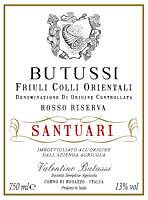
|
|
Colli Orientali del Friuli Rosso Riserva Santuari 2016 |
|
| Valentino Butussi (Friuli-Venezia Giulia, Italy) | |
 Cabernet Sauvignon Cabernet Sauvignon | |
| Price: € 50.00 | Score: |
 Intense ruby red and nuances of garnet red, little transparency. Intense ruby red and nuances of garnet red, little transparency. Intense, clean, pleasing, refined and elegant, starts with hints of
black currant, blueberry and plum followed by aromas of violet, black
cherry, chocolate, tobacco, leather, mace, vanilla and eucalyptus. Intense, clean, pleasing, refined and elegant, starts with hints of
black currant, blueberry and plum followed by aromas of violet, black
cherry, chocolate, tobacco, leather, mace, vanilla and eucalyptus.
 Properly tannic attack and however balanced by alcohol, good body,
intense flavors, agreeable. Properly tannic attack and however balanced by alcohol, good body,
intense flavors, agreeable.
 Persistent finish with flavors of black currant, blueberry and plum. Persistent finish with flavors of black currant, blueberry and plum. 24 months in cask, 6 months in cement tanks, 12 months in bottle. 24 months in cask, 6 months in cement tanks, 12 months in bottle. |
|
 Stewed meat with mushrooms, Roasted meat, Hard cheese Stewed meat with mushrooms, Roasted meat, Hard cheese |
|

|
|
Il 150 Negroamaro Rosso 2019 |
|
| Apollonio (Apulia, Italy) | |
 Negroamaro Negroamaro | |
| Price: € 10.00 | Score: |
 Intense ruby red and nuances of purple red, little transparency. Intense ruby red and nuances of purple red, little transparency. Intense, clean, pleasing and refined, starts with hints of black
cherry, blackberry and plum followed by aromas of violet, strawberry,
raspberry, carnation and blueberry. Intense, clean, pleasing and refined, starts with hints of black
cherry, blackberry and plum followed by aromas of violet, strawberry,
raspberry, carnation and blueberry.
 Properly tannic attack and however balanced by alcohol, good body,
intense flavors, agreeable. Properly tannic attack and however balanced by alcohol, good body,
intense flavors, agreeable.
 Persistent finish with flavors of black cherry, blackberry and plum. Persistent finish with flavors of black cherry, blackberry and plum. 3 months in steel tanks. 3 months in steel tanks. |
|
 Cold cuts, Pasta with mushrooms, Sauteed meat, Stewed meat, Legume soups Cold cuts, Pasta with mushrooms, Sauteed meat, Stewed meat, Legume soups |
|

|
|
Primitivo di Manduria Mani del Sud 2015 |
|
| Apollonio (Apulia, Italy) | |
 Primitivo Primitivo | |
| Price: € 16.00 | Score: |
 Deep ruby red and nuances of garnet red, little transparency. Deep ruby red and nuances of garnet red, little transparency. Intense, clean, pleasing and refined, starts with hints of plum jam,
black cherry jam and blackberry jam followed by aromas of dried violet,
carob, tobacco, licorice, leather, mace, vanilla and menthol. Intense, clean, pleasing and refined, starts with hints of plum jam,
black cherry jam and blackberry jam followed by aromas of dried violet,
carob, tobacco, licorice, leather, mace, vanilla and menthol.
 Properly tannic attack and however balanced by alcohol, good body,
intense flavors, pleasing roundness. Properly tannic attack and however balanced by alcohol, good body,
intense flavors, pleasing roundness.
 Persistent finis with flavors of plum jam, black cherry jam and
blackberry jam. Persistent finis with flavors of plum jam, black cherry jam and
blackberry jam.
 6 months in barrique, 6 months in cask, 6 months in bottle. 6 months in barrique, 6 months in cask, 6 months in bottle. |
|
 Roasted meat, Stewed meat with mushrooms, Hard cheese Roasted meat, Stewed meat with mushrooms, Hard cheese |
|

|
|
Perlato del Bosco Vermentino 2019 |
|
| Tua Rita (Tuscany, Italy) | |
 Vermentino Vermentino | |
| Price: € 15.00 | Score: |
 Brilliant greenish yellow and nuances of greenish yellow, very
transparent. Brilliant greenish yellow and nuances of greenish yellow, very
transparent.
 Intense, clean, pleasing and refined, starts with hints of apple, pear
and peach followed by aromas of pineapple, hawthorn, lemongrass, broom,
plum, almond and mineral. Intense, clean, pleasing and refined, starts with hints of apple, pear
and peach followed by aromas of pineapple, hawthorn, lemongrass, broom,
plum, almond and mineral.
 Crisp attack and however balanced by alcohol, good body, intense
flavors, agreeable. Crisp attack and however balanced by alcohol, good body, intense
flavors, agreeable.
 Persistent finish with flavors of apple, pear and peach. Persistent finish with flavors of apple, pear and peach. Aged in steel tanks. Aged in steel tanks. |
|
 Pasta with fish, Sauteed fish, Sauteed white meat, Fried fish, Dairy products Pasta with fish, Sauteed fish, Sauteed white meat, Fried fish, Dairy products |
|
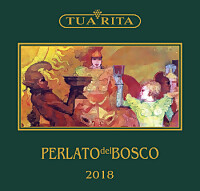
|
|
Perlato del Bosco Sangiovese 2018 |
|
| Tua Rita (Tuscany, Italy) | |
 Sangiovese Sangiovese | |
| Price: € 25.00 | Score: |
 Brilliant ruby red and nuances of ruby red, little transparency. Brilliant ruby red and nuances of ruby red, little transparency. Intense, clean, pleasing and refined, starts with hints of black
cherry, plum and raspberry followed by aromas of violet, rose, blueberry,
chocolate, juniper, vanilla and menthol. Intense, clean, pleasing and refined, starts with hints of black
cherry, plum and raspberry followed by aromas of violet, rose, blueberry,
chocolate, juniper, vanilla and menthol.
 Properly tannic attack and however balanced by alcohol, good body,
intense flavors, agreeable. Properly tannic attack and however balanced by alcohol, good body,
intense flavors, agreeable.
 Persistent finish with flavors of black cherry, plum and raspberry. Persistent finish with flavors of black cherry, plum and raspberry. Aged in barrique and cask. Aged in barrique and cask. |
|
 Broiled meat and barbecue, Roasted meat, Stewed meat with mushrooms, Cheese Broiled meat and barbecue, Roasted meat, Stewed meat with mushrooms, Cheese |
|
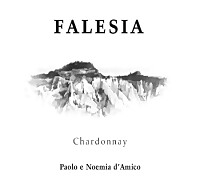
|
|
Falesia 2018 |
|
| Paolo e Noemia d'Amico (Latium, Italy) | |
 Chardonnay Chardonnay | |
| Price: € 22.00 | Score: |
 Brilliant straw yellow and nuances of straw yellow, very transparent. Brilliant straw yellow and nuances of straw yellow, very transparent. Intense, clean, pleasing, refined and elegant, starts with hints of
banana, apple and acacia followed by aromas of pear, grapefruit, pineapple,
broom, plum, honey, hawthorn, butter, mineral and hints of vanilla. Intense, clean, pleasing, refined and elegant, starts with hints of
banana, apple and acacia followed by aromas of pear, grapefruit, pineapple,
broom, plum, honey, hawthorn, butter, mineral and hints of vanilla.
 Crisp attack and however balanced by alcohol, good body, intense
flavors, pleasing roundness. Crisp attack and however balanced by alcohol, good body, intense
flavors, pleasing roundness.
 Persistent finish with flavors of banana, plum and grapefruit. Persistent finish with flavors of banana, plum and grapefruit. 10 months in barrique, 5 months in bottle. 10 months in barrique, 5 months in bottle. |
|
 Pasta with fish, Broiled crustaceans, Stewed fish, Sauteed white meat Pasta with fish, Broiled crustaceans, Stewed fish, Sauteed white meat |
|

|
|
Atlante 2013 |
|
| Paolo e Noemia d'Amico (Umbria, Italy) | |
 Cabernet Franc Cabernet Franc | |
| Price: € 36.00 | Score: |
 Brilliant ruby red and nuances of garnet red, little transparency. Brilliant ruby red and nuances of garnet red, little transparency. Intense, clean, pleasing, refined and elegant, starts with hints of
black currant, plum and black cherry followed by aromas of dried violet,
blueberry, bell pepper, chocolate, cinnamon, tobacco, leather, mace,
vanilla and eucalyptus. Intense, clean, pleasing, refined and elegant, starts with hints of
black currant, plum and black cherry followed by aromas of dried violet,
blueberry, bell pepper, chocolate, cinnamon, tobacco, leather, mace,
vanilla and eucalyptus.
 Properly tannic attack and however balanced by alcohol, good body,
intense flavors, agreeable. Properly tannic attack and however balanced by alcohol, good body,
intense flavors, agreeable.
 Persistent finish with flavors of black currant, black cherry and plum. Persistent finish with flavors of black currant, black cherry and plum. 12 months in barrique, 10 months in bottle. 12 months in barrique, 10 months in bottle. |
|
 Stewed meat with mushrooms, Broiled meat and barbecue, Roasted meat Stewed meat with mushrooms, Broiled meat and barbecue, Roasted meat |
|
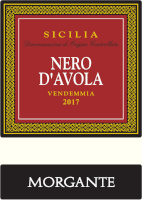
|
|
Sicilia Nero d'Avola 2017 |
|
| Morgante (Sicily, Italy) | |
 Nero d'Avola Nero d'Avola | |
| Price: € 9.68 | Score: |
 Brilliant ruby red and nuances of runy red, moderate transparency. Brilliant ruby red and nuances of runy red, moderate transparency. Intense, clean, pleasing and refined, starts with hints of blackberry,
black cherry and plum followed by aromas of violet, geranium, raspberry,
blueberry, carob, tobacco, vanilla and menthol. Intense, clean, pleasing and refined, starts with hints of blackberry,
black cherry and plum followed by aromas of violet, geranium, raspberry,
blueberry, carob, tobacco, vanilla and menthol.
 Properly tannic attack and however balanced by alcohol, good body,
intense flavors, pleasing roundness. Properly tannic attack and however balanced by alcohol, good body,
intense flavors, pleasing roundness.
 Persistent finish with flavors of blackberry, black cherry and plum. Persistent finish with flavors of blackberry, black cherry and plum. Aged in barrique. Aged in barrique. |
|
 Stuffed pasta, Broiled meat and barbecue, Stewed meat with mushrooms Stuffed pasta, Broiled meat and barbecue, Stewed meat with mushrooms |
|
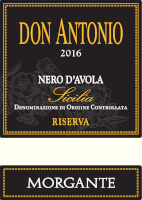
|
|
Sicilia Nero d'Avola Riserva Don Antonio 2016 |
|
| Morgante (Sicily, Italy) | |
 Nero d'Avola Nero d'Avola | |
| Price: € 27.12 | Score: |
 Intense ruby red and nuances of garnet red, little transparency. Intense ruby red and nuances of garnet red, little transparency. Intense, clean, pleasing, refined and elegant, starts with hints of
blackberry, black cherry and violet followed by aromas of plum, blueberry,
cocoa, carob, tobacco, cinnamon, leather, vanilla and menthol. Intense, clean, pleasing, refined and elegant, starts with hints of
blackberry, black cherry and violet followed by aromas of plum, blueberry,
cocoa, carob, tobacco, cinnamon, leather, vanilla and menthol.
 Properly tannic attack and however balanced by alcohol, good body,
intense flavors, pleasing roundness. Properly tannic attack and however balanced by alcohol, good body,
intense flavors, pleasing roundness.
 Persistent finish with flavors of blackberry, black cherry and plum. Persistent finish with flavors of blackberry, black cherry and plum. 12 months in barrique, 12 months in bottle. 12 months in barrique, 12 months in bottle. |
|
 Broiled meat and barbecue, Roasted meat, Stewed meat with mushrooms, Hard cheese Broiled meat and barbecue, Roasted meat, Stewed meat with mushrooms, Hard cheese |
|
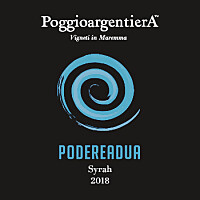
|
|
Podereadua 2018 |
|
| Poggio Argentiera (Tuscany, Italy) | |
 Syrah Syrah | |
| Price: € 22.00 | Score: |
 Intense ruby red and nuances of ruby red, little transparency. Intense ruby red and nuances of ruby red, little transparency. Intense, clean, pleasing, refined and elegant, starts with hints of
black currant, black cherry and plum followed by aromas of violet,
blueberry, blackberry, chocolate, tobacco, black pepper, vanilla and
eucalyptus. Intense, clean, pleasing, refined and elegant, starts with hints of
black currant, black cherry and plum followed by aromas of violet,
blueberry, blackberry, chocolate, tobacco, black pepper, vanilla and
eucalyptus.
 Properly tannic attack and however balanced by alcohol, good body,
intense flavors, agreeable. Properly tannic attack and however balanced by alcohol, good body,
intense flavors, agreeable.
 Persistent finish with flavors of black currant, black cherry and plum. Persistent finish with flavors of black currant, black cherry and plum. 14 months in cask, 12 months in bottle. 14 months in cask, 12 months in bottle. |
|
 Broiled meat and barbecue, Roasted meat, Stewed meat with mushrooms, Cheese Broiled meat and barbecue, Roasted meat, Stewed meat with mushrooms, Cheese |
|
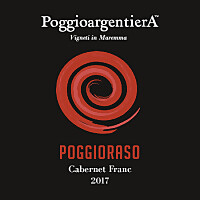
|
|
Poggioraso 2017 |
|
| Poggio Argentiera (Tuscany, Italy) | |
 Cabernet Franc Cabernet Franc | |
| Price: € 25.00 | Score: |
 Intense ruby red and nuances of garnet red, little transparency. Intense ruby red and nuances of garnet red, little transparency. Intense, clean, pleasing, refined and elegant, starts with hints of
black currant, black cherry and blueberry followed by aromas of violet,
plum, bell pepper, chocolate, tobacco, mace, pink pepper, vanilla and
menthol. Intense, clean, pleasing, refined and elegant, starts with hints of
black currant, black cherry and blueberry followed by aromas of violet,
plum, bell pepper, chocolate, tobacco, mace, pink pepper, vanilla and
menthol.
 Properly tannic attack and however balanced by alcohol, good body,
intense flavors, agreeable. Properly tannic attack and however balanced by alcohol, good body,
intense flavors, agreeable.
 Persistent finish with flavors of black currant, black cherry and
blueberry. Persistent finish with flavors of black currant, black cherry and
blueberry.
 14 months in barrique. 14 months in barrique. |
|
 Roasted meat, Stewed meat with mushrooms, Cheese Roasted meat, Stewed meat with mushrooms, Cheese |
|
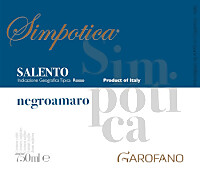
|
|
Simpotica 2015 |
|
| Severino Garofano - Tenuta Monaci (Apulia, Italy) | |
 Negroamaro (90%), Montepulciano (10%) Negroamaro (90%), Montepulciano (10%) | |
| Price: € 17.50 | Score: |
 Intense ruby red and nuances of garnet red, little transparency. Intense ruby red and nuances of garnet red, little transparency. Intense, clean, pleasing and refined, starts with hints of prune,
blackberry and dried violet followed by aromas of black cherry, blueberry,
carob, tobacco, leather, vanilla and menthol. Intense, clean, pleasing and refined, starts with hints of prune,
blackberry and dried violet followed by aromas of black cherry, blueberry,
carob, tobacco, leather, vanilla and menthol.
 Properly tannic attack and however balanced by alcohol, good body,
intense flavors, pleasing roundness. Properly tannic attack and however balanced by alcohol, good body,
intense flavors, pleasing roundness.
 Persistent finish with flavors of prune, blackberry and black cherry. Persistent finish with flavors of prune, blackberry and black cherry. 12 months in barrique, 6 months in bottle. 12 months in barrique, 6 months in bottle. |
|
 Broiled meat and barbecue, Roasted meat, Stewed meat with mushrooms, Cheese Broiled meat and barbecue, Roasted meat, Stewed meat with mushrooms, Cheese |
|
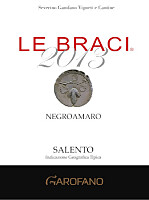
|
|
Le Braci 2013 |
|
| Severino Garofano - Tenuta Monaci (Apulia, Italy) | |
 Negroamaro Negroamaro | |
| Price: € 40.00 | Score: |
 Brilliant ruby red and nuances of garnet red, little transparency. Brilliant ruby red and nuances of garnet red, little transparency. Intense, clean, pleasing, refined and elegant, starts with hints of
plum, blackberry and dried violet followed by aromas of black cherry,
blueberry, carob, clove, licorice, tobacco, leather, vanilla and menthol. Intense, clean, pleasing, refined and elegant, starts with hints of
plum, blackberry and dried violet followed by aromas of black cherry,
blueberry, carob, clove, licorice, tobacco, leather, vanilla and menthol.
 Properly tannic attack and however balanced by alcohol, good body,
intense flavors, pleasing roundness. Properly tannic attack and however balanced by alcohol, good body,
intense flavors, pleasing roundness.
 Persistent finish with flavors of plum, blackberry and black cherry. Persistent finish with flavors of plum, blackberry and black cherry. 12 months in barrique, 18 months in bottle. 12 months in barrique, 18 months in bottle. |
|
 Roasted meat, Broiled meat and barbecue, Stewed and braised meat with mushrooms, Hard cheese Roasted meat, Broiled meat and barbecue, Stewed and braised meat with mushrooms, Hard cheese |
|
News |
|
In this section are published news and information about events concerning the world of wine and food. Whoever is interested in publishing this kind of information can send us a mail to our address.
|
AquavitaeReview of Grappa, Distillates and Brandy |
|
|
||||||||||||
Wine Guide ParadeMay 2020
|
| |||||||
Privacy Policy | |||||||


| Copyright © 2002-2024 Antonello Biancalana, DiWineTaste - All rights reserved |
| All rights reserved under international copyright conventions. No part of this publication and of this WEB site may be
reproduced or utilized in any form or by any means, electronic or mechanical, without permission in writing from DiWineTaste. |